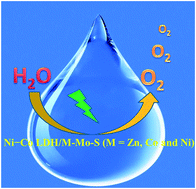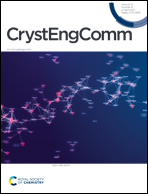Ni–Co LDH/M–Mo–S (M = Zn, Co and Ni) nanoarrays as efficient water oxidation electrocatalytic materials†
Abstract
It is possible to research the influencing factors of the electrocatalytic water splitting activity by controlling the composition and morphology of the materials. In this study, an efficient morphology control of Ni–Co layered double hydroxide/M–Mo–S (M = Zn, Co and Ni) hybrid materials was investigated by introducing different metal ions into M–Mo–S. An adjustable morphology was successfully achieved by taking the advantage of the growth mechanism of the Kirkendall growth and Ostwald ripening. The Ni–Co LDH/Ni–Mo–S catalyst displayed an extraordinary oxygen evolution reaction performance (overpotential of 290 mV at 40 mA cm−2) and a superior durability (retention rate of 90%) at 10 mA cm−2 after 14 h compared to Ni–Co LDH/M–Mo–S (M = Zn, Co and Ni) hybrid materials. A series of characterization analyses demonstrate that the efficient electrochemistry performance of the material is assigned to the improved electrical conductivity, greater exposure to active sites and faster oxygen outflow rate. The density functional theory calculation results suggest that the in situ generated Mo-doped NiOOH has the optimal adsorption energy of water compared to NiOOH, which is probably the main active center in the water oxidation reaction. Our study presents a new way of thinking for the development of high efficiency heterojunction catalysts and guidance for the further realization of the industrialization of electrolytic water.

- This article is part of the themed collection: Nanomaterials

 Please wait while we load your content...
Please wait while we load your content...